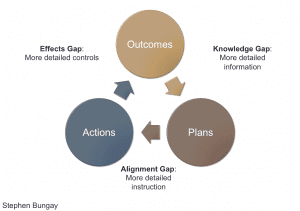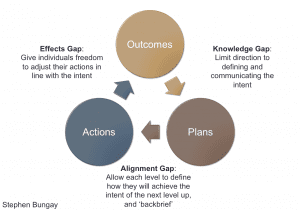A fourth post exploring the relationship between Strategy Deployment and other approaches (see Strategy Deployment and Fitness for Purpose, Strategy Deployment and AgendaShift and Strategy Deployment and Spotify Rhythm).
Directed Opportunism is the approach described by Stephen Bungay in his book The Art of Action, in which he builds on the ideas of Field Marshall Helmuth von Moltke, Chief of Staff of the Prussian Army for 30 years from 1857, and applies them to leading businesses. This also follows on from the earlier post on alignment and autonomy in Strategy Deployment.
Bungay starts by describing three gaps between desired Outcomes, the Plans made to achieve them, and the Actions taken which create actual Outcomes. These gaps (the Knowledge Gap, Alignment Gap and Effects Gap) are shown in the diagram below, and together cause organisational friction – resistance of the organisation to meeting its goals.
Given this model, Bungay explains how the usual approach to reducing this friction, and closing the gaps, is to attempt to reduce uncertainty by pursuing more detail and control, as show below.
This generally makes the situation worse, however, because the problem is not linear, reductionistic or deterministic. In Cynefin terms, this is a Complicated approach in a Complex domain. Instead, Bungay recommends reducing detail and control and allowing freedom to evolve with feedback. This is what he calls Directed Opportunism.
This definition of Directed Opportunism seems to me to meet my definition of Strategy Deployment as a form of organisational improvement in which solutions emerge from the people closest to the problem. There is clear communication of intent (the problem) with each level (the people closest) defining how they well achieve the intent (the solution) and having freedom to adjust in line with the intent (the emergence).
From an X-Matrix perspective, being clear on results, strategies and outcomes limits direction to defining and communicating intent, and leaving tactics to emerge (through Catchball) allows different levels to define how they will achieve the intent and gives them freedom to adjust actions in line with the intent.



